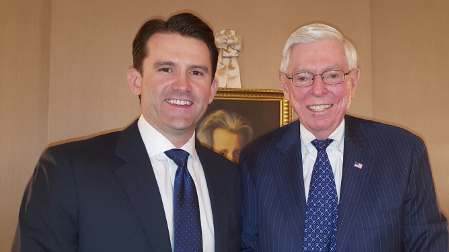Sinclair's Ripley: Without Consolidation, TV Broadcasting Will 'Cease to Exist'
WASHINGTON—Sinclair Broadcast Group President and CEO Christopher Ripley doesn’t argue the fact that the broadcaster is one of the largest in the country, but what he does want people to know is that in this new ecosystem it is actually one of the smallest competitors. Among the competitors Ripley named to those in attendance at the Media Institute Luncheon in Washington D.C. on Tuesday, were the likes of AT&T, Google, Facebook and Amazon.
“When you look at the entire media communications industry, TV broadcast is a pimple in the entirety of that industry,” Ripley said. “We’re the largest TV broadcaster by far, but yet we are so tiny compared to AT&T, Verizon, Comcast, Charter, Google, Facebook, Amazon. And all those names are people we interface with. They’re either customers or vendors or competitors or would-be competitors. So that’s the ecosystem we play in.”
This, Ripley believes, is why he thinks Sinclair’s deal with Tribune will ultimately close, possibly as soon as the end of the calendar year. “We just sort of scratch our heads from a regulatory basis why there can be any grounds to prevent such consolidation from happening when if it doesn’t happen we’ll simply cease to exist as an industry.”
Ripley also praised FCC Chairman Ajit Pai for reviewing certain rules, like station ownership, that could not only help the Tribune deal be approved, but help Sinclair compete in the new environment.
“We’ve been on record saying all the rules, for the most part, that govern this industry are circa 1960s, 1970s; so antiquated for a bygone era,” he told attendees. “We welcome any sort of relief from that front. If that means some of the local ownership rules are reformed or go away, that’s definitely a positive step.”

Christoper Ripley and Dick Wiley, who served as the session's moderator. (Photo credit: Gary Arlen)
On the programming side of things, Ripley said Sinclair is developing an “overlay network” that will supplement programming on its affiliate stations. “We don't envision creating a new network to compete” with existing networks, Ripley said. Instead, this overlay would “supplement to enhance existing networks we already carry.”
Another element that Sinclair anticipates will impact its ability to compete is the rollout of the next-generation TV standard ATSC 3.0. Ripley says that Sinclair is a big champion of the standard—it, along with Univision and NextStar, is leading a consortium with ATSC 3.0 as a focus point—and sees many benefits for Sinclair and the industry at large, including the standard’s mobile first aspects; being IP end-to-end; the use of targeted ads; and increase content data transfer capability.
Get the TV Tech Newsletter
The professional video industry's #1 source for news, trends and product and tech information. Sign up below.
One of the last potential hurdles for Sinclair, and the broadcast industry as a whole, will be the transition to ATSC 3.0 from the current ATSC 1.0 standard. Ripley says that Sinclair will simulcast both the ATSC 1.0 and 3.0 standards for its stations until a point is reached where all TVs are 3.0-capable and 1.0 can be switched off, though he admits that will need to be a collaborative effort among broadcasters and will be done on a market-by-market basis.
Still, Ripley believes that this new ecosystem will impact the next-gen TV standard as well. Using the example of a test Sinclair participated in December 2016 with automated cars, ATSC 3.0’s capabilities could range beyond that of traditional broadcast. “My prediction for ATSC 3.0 is that ultimately it will not end up being used for what everyone thinks it will be used for today—mobile video or video to the home,” said Ripley. “It will be used for another purpose.”
